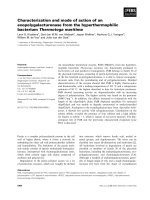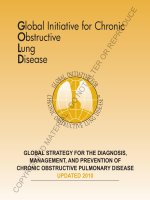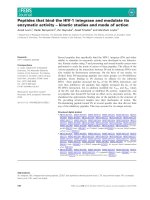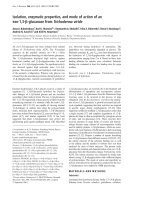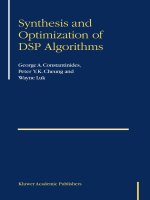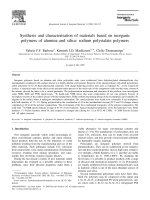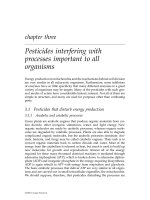Agents for hepatocellular carcinoma synthesis and mode of action
Bạn đang xem bản rút gọn của tài liệu. Xem và tải ngay bản đầy đủ của tài liệu tại đây (10.85 MB, 263 trang )
AGENTS FOR HEPATOCELLULAR CARCINOMA:
SYNTHESIS AND MODE OF ACTION
CHEN XIAO
(B.Sc., NANJING UNIVERSITY)
A THESIS SUBMITTED
FOR THE DEGREE OF DOCTOR OF PHILOSOPHY
DEPARTMENT OF PHARMACY
NATIONAL UNIVERSITY OF SINGAPORE
2014
I h
e
its
e
use
d
Thi
s
e
reby decla
r
e
ntirety. I h
a
d
in the the
s
s
thesis has
r
e that this t
a
ve duly ac
k
s
is.
also not b
e
D
hesis is my
k
nowledge
d
e
en submitt
e
i
D
eclaratio
original w
o
d
all the so
u
e
d for any
d
n
o
rk and it h
a
u
rces of inf
o
d
egree in an
Signat
u
a
s been wri
t
o
rmation w
h
y universit
y
Chen
X
u
re:
Jan 21,
t
ten by me
h
ich have
b
y
previousl
y
X
iao
2014
i
n
b
een
y
.
ii
Acknowledgement
I would like to dedicate my acknowledgement to my supervisor, Associate Professor Go Mei
Lin for her constant guidance and support. Without her advices and insights, this piece of
thesis work would not be possible.
I am grateful to my co-supervisor, Dr Ho Han Kiat for his valuable advices and
encouragement. I am grateful to Dr Gautam Sethi from Department of pharmacology, Yong
Loo Ling School of Medicine, NUS, for his guidance on most of the pharmacological work. I
am grateful to Dr Jin Haixiao from Ningbo University for her guidance of the molecular
docking.
Then I would like to thank all my seniors and other labmates for their help on my bench work.
Namely, they are Dr Yang Tianming, Dr Zhang Wei, Dr Lee Chong Yew, Dr Sim Hong May,
Dr Wee Xi Kai, Dr Yeo Wee Kiang, Dr Pondy Murugappan Ramanujulu Sam, Dr Tan Kheng
Lin Meg, Ms Pang Yi Yun, Ms Yap Siew Qi and Mr Ho Si Han Sheman.
I am also appreciated the undergraduate students in our lab, namely Mr Ng Boon Kiang Ivan,
Ms Ang Ai Ling Irene, Ms Low Ying Xiu, Ms Loke Mei Xin, Mr Shih Shan Wei Shannon,
Mr Lee Kwok Loong Sylvester for their hard work.
I am grateful for the assistance of the lab technicians Mdm Oh Tang Booy, Ms Ng Sek Eng,
Mr Li Feng.
I would like to thank the support and encouragement from my family and friends. I would like
to thank specially to my fiancé Dr Sun Lingyi for the four-year companionship during the
time I pursued the phD degree.
Finally, I would like to acknowledge the financial support for my graduate studies form the
National University of Singapore Research Scholarship.
iii
Table of Content
Declaration i
Acknowledgement ii
Summary viii
Abbreviations List xii
List of Figures xiv
List of Schemes xx
List of Tables xxi
Chapter 1 Introduction 1
1.1. Background of Hepatocellular Carcinoma (HCC): Epidemiology, risk factors
and management 1
1.2. Molecular targeted therapy for HCC 2
1.3. Sorafenib as targeted therapy for advanced HCC 3
1.3.1. Resistance to sorafenib treatment in HCC 4
1.4. Other molecular targeted therapies for HCC 8
1.5. Sirtuins as emerging therapeutic targets for HCC 9
1.5.1. Functions of sirtuins 11
1.5.2. Sirtuins and cancer 13
1.5.3. Sirtuins in HCC 15
1.5.3.1. SIRT 1 in HCC 15
1.5.3.2. SIRT 2 in HCC 16
1.5.4. Functionalized indolin-2-ones as sirtuin inhibitors 16
1.6. Functionalized indolin-2-ones as inhibitors of kinases 17
1.7. Compound 47: A multi-targeting kinase inhibitor with growth inhibitory
effects on a panel of HCC cells. 25
1.8. Statement of purpose 26
Chapter 2 Design and Synthesis of Target Compounds: 3-substituted Indolin-2-ones 29
2.1. Introduction 29
2.2. Rationale of design 29
2.3. Chemical considerations 35
2.3.1. Syntheses of benzylidene indolinones of Series 1-8 35
iv
2.3.2.
Syntheses of 3-formyl-benzenesulfonamide and 3-formyl-N-substituted-
benzenesulfonamide 37
2.3.3. Synthesis of 5,6-difluoro-oxindole 38
2.3.4. Syntheses of 1-methyl-oxindole and 6-chloro-1-methyl-oxindole 39
2.3.5. Synthesis of 3-arylimino-2-indolones of Series 8 40
2.4. Assignment of configuration 40
2.5. Summary 55
2.6. Experimental methods 56
2.6.1. General details 56
2.6.2. X-ray crystal structure of Compound 6-6 57
2.6.3. General procedure for the synthesis of 3-benzylidene indolin-2-ones of
Series 1-8 58
2.6.4. Synthesis of sulfamoyl and N-substituted sulfamoyl benzoic acids 58
2.6.5. Synthesis of formyl benzenesulfonamides 59
2.6.6. Synthesis of 5,6-difluoro-oxindole 60
2.6.7. Synthesis of 1-methyl-oxindole and 6-chloro-1-methyl-oxindole 61
2.6.8. General procedure for the synthesis of 3-phenylimino-2-indolones (8-2, 8-4,
8-6, 8-7) 62
Chapter 3: Investigations into the growth inhibitory activities of Series 1-8 compounds on
malignant liver cancer cell lines 63
3.1. Introduction 63
3.2. Materials and Methods 63
3.2.1. Reagents 63
3.2.2. Cell Lines and cell culture. 64
3.2.3. MTT assay for determination of cell growth inhibition 64
3.2.4. Detection of Apoptosis by flow cytometry 65
3.2.5. Preparation of HuH7 cell lysates 66
3.2.6. Protein quantification 66
3.2.7. Sodium dodecyl sulfate - polyacrylamide gel electrophoresis (SDS-PAGE) 67
3.2.8. Western blotting 67
3.3. Results 68
3.3.1. Growth inhibitory activities of Series 1-8 on HuH7 cells 68
3.3.1.1. Growth inhibitory activities of Series 2, 3 and 4 compounds 70
v
3.3.1.2.
Growth inhibitory activities of Series 6 and 7 compounds 72
3.3.1.3. Growth inhibitory activities of Series 5 compounds 74
3.3.1.4. Growth inhibitory activities of Series 8 compounds 76
3.3.2. Growth inhibitory properties of selected compounds on Hep3B and HepG2 78
3.3.3. Growth inhibitory properties and selectivity ratios of selected compounds on
IMR 90 cell 81
3.3.4. Investigations into the induction of apoptotic cell death of HuH7 cells by
selected test compounds 83
3.4. Discussion 87
3.5. Summary 91
Chapter 4 : Investigations into the sirtuin inhibitory activities of selected compounds from
Series 1-8. 93
4.1. Introduction 93
4.2. Materials and Methods 93
4.2.1. Reagents 93
4.2.2. Principle of sirtuin enzyme assay 94
4.2.3. Measurement of sirtuin activity 95
4.2.4. Preparation of HuH7 or Hep G2 cell lysates 97
4.2.5. Protein quantification 97
4.2.6. Sodium dodecyl sulfate - polyacrylamide gel electrophoresis (SDS-PAGE) 97
4.2.7. Western blotting 97
4.2.8. Molecular Docking 97
4.3. Results 98
4.3.1. Inhibition of sirtuin activities by selected test compounds 98
4.3.2. Validation of sirtuin inhibition by compounds 5-1 and 8-7 using Western blot
analysis 100
4.3.3. Molecular docking of functionalized benzylidene indolinones in the SIRT2
binding pocket 103
4.3.3.1. Docking analysis of Z isomers of test compounds on SIRT2 106
4.3.3.2. Docking analysis of E isomers of test compounds on SIRT2 113
4.3.4. Docking analysis of Z isomers and E isomers of test compounds on SIRT1 . 117
4.4. Discussion 117
4.5. Summary 121
vi
Chapter 5: Investigations into the receptor tyrosine kinase (RTK) inhibitory activity of
Compound 3-12. 122
5.1. Introduction 122
5.2. Experimental methods 122
5.2.1. Chemicals and Materials 122
5.2.2. Preparation of HuH7 cell lysates 122
5.2.3. Protein quantification 123
5.2.4. Immunoprecipitation 123
5.2.5. Sodium dodecyl sulfate - polyacrylamide gel electrophoresis (SDS-PAGE) . 123
5.2.6. Western blotting 123
5.2.7. Human receptor tyrosine kinase profiling 124
5.2.7.1. Principle of human phospho-receptor tyrosine kinase array 124
5.2.7.2. Procedure 124
5.2.8. FGFR4 homology model and molecular docking 126
5.3. Results 127
5.3.1. Effects of 47 and 3-12 on the phosphorylated states of RTKs in HuH7 cells 127
5.3.2. Molecular docking of 3-12 in a homology model of human FGFR4 131
5.4. Discussion 136
5.5. Summary 140
Chapter 6: Investigation of the drug-like properties of selected benzylidene indolinones 141
6.1. Introduction 141
6.2. Materials and Methods 141
6.2.1. Determination of aqueous solublility 141
6.2.2. Determination of in vitro stability of compound 47, 1-23, 3-12, and 7-6 in the
presence of rat male liver microsomes 143
6.2.3. Assessment of aggregation tendency by dynamic light scattering (DLS) 144
6.2.4. Determination of PAMPA permeability 145
6.2.5. Determination of cytotoxicities of test compounds 145
6.2.6. Determination of genotoxicities of test compounds 145
6.3. Results 145
6.3.1. Aqueous solubilities of compounds 47, 1-18, 1-23, 3-10, 3-12 and 7-6. 145
6.3.2. PAMPA permeabilities of compounds 47, 1-18, 1-23, 3-10, 3-12 and 7-6. 146
vii
6.3.3.
In vitro metabolic stability of 47, 1-23, 3-12 and 7-6. 148
6.3.4. In vitro cytotoxicities and genotoxicities of 47, 1-23, 3-12 and 7-6. 149
6.4. Aggregate formation by test compounds 151
6.4.1. Maximum tolerated dose of 3-12 in mice 152
6.5. Discussion 153
6.6. Summary 155
Chapter 7: Conclusions 156
Reference 161
Appendix I: Characterization of synthesized analogues 174
Appendix II Compounds that were not done by the candidate: Method and Charaterization 222
Appendix III:Crystal data and structure refinement for 6-6 233
Appendix IV : The second attempt of Western blot analysis of sirtuin inhibition by
compounds 5-1 and 8-7 234
Appendix V: Determinations of drug likeness properties of the test compounds that are done
by Drug Development Unit of NUS. 235
Appendix VI: Purity data of the synthesized compounds 238
viii
Summary
The benzylideneindolinone scaffold is historically linked to the inhibition of receptor tyrosine
kinases (RTKs) and several functionalized analogs have shown promising anticancer activity
by inhibiting the aberrant activities of oncogenic RTKs. The compound, E/Z 6-chloro-3-(3-
trifluoromethyl-benzyliden)-1,3-dihydroindol-2-one (Compound 47) identified in the
candidate laboratory was of particular interest. It exhibited potent and selective growth
inhibitory effects on hepatocellular carcinoma (HCC) cells, inhibited selected RTKs,
intercepted prosurvival and proliferation mechanisms and showed in vivo efficacy in
xenograft models. However 47 was hampered by its poor physicochemical profile. It was a
lipophilic molecule (ClogP 5.08) with poor aqueous solubility (0.09 µM or 0.03 μg /mL, pH
7.4) and limited permeability when assessed by the parallel artificial membrane permeation
assay (PAMPA). Thus the aim of this thesis was to test the hypothesis that structural
elaboration of the underfunctionalized 47 would provide a means of uncovering drug-like
compounds with greater potency and selectivity on HCC. It was envisaged that the enhanced
potency would arise from kinase or sirtuin inhibition, or possibly, through inhibition of both
targets. To this end, 115 compounds across 8 series of functionalized benzylideneindolinones
were designed, synthesized and evaluated for their effects on the viability of liver cancer cell
lines (HuH7, Hep3B, HepG2). The focus of the design strategy was to enhance the drug-like
character of the lead compound 47, notably its poor solubility and excessive lipophilicity.
The approach was to introduce polar substituents at two sites of the scaffold, namely the
indolinone ring A and the benzylidene ring B.
Based on the growth inhibitory activities on HuH7 cells, a comprenhensive structure activity
relationship was deduced for the benzylidene indolinone scaffold. The main points were (i)
The E/Z configuration of the exocyclic methine (=C-) bond did not appear to play a major
role in influencing activity; (ii) Replacement of the exocyclic methine with azomethine (=C-
Æ =N-) abolished activity; (iv) Substitution on the lactam N did not adversely affect activity;
(iv) On the indolinone ring A, there was a preference for substitution at position 6 (6-F > 6-Cl)
as compared to position 5. Difluoro substitution (at positions 4,5 or 5,6) improved activity but
ix
only when the benzylidene ring was substituted with 3’CF
3
. (v) Series 5 compounds which
were substituted on ring A with 6-methoxy had exceptionally potent activity but may have a
“cytostatic” component in their growth inhibitory effects. (vi)The choice of substituents on
the benzylidene ring B had a marked effect on activity, possibly exceeding that of the
indolinone ring A. Two substituents were associated with potent activity: 3’CF
3
and 3’N-
substituted aminosulfonyl. There was a significant regioisomeric preference for position 3’.
Optimal ring A and ring B combinations for potent activity were evident: For 6-F and 6-
methoxy on ring A, the N-substituted aminosulfonyl was preferred, whereas for 6-Cl on ring
A, both CF
3
and N-substituted aminosulfonyl sidechains were acceptable. For other
halogenated ring A analogs (5-Cl, 4,5-F, 5,6-F), the CF
3
on ring B was preferred. One
difference between the two ring B side chains was that analogs with CF
3
were selectively
more potent on HuH7 cells compared to non-malignant IMR90 cells; (vii) A robust SAR was
observed for compounds bearing the N-substituted aminosulfonyl side chain, namely a
distinct preference for mono N-substitution, an increase in growth inhibitory activity on
homologation (H > N-methyl > N-ethyl > N-n-propyl), and the negative impact on potency
imparted by branching (propyl Æ isopropyl) and reversal of the aminosulfonyl side chain
(MeNHSO
2
- Æ MeSO
2
NH-).
Selected compounds were screened on other hepatoma cells and in general, compounds that
were potent on HuH7 (IC
50
< 1 µM) were equipotent on Hep3B but less so on HepG2.
Interestingly, HuH7 and Hep3B were mutated p53 cell lines whereas HepG2 harboured wild
type p53. p53 is the most frequently mutated gene in HCC and the greater susceptibilities of
cells bearing mutated p53 may suggest that signaling pathways associated with the loss of
function or gain of a new function due to p53 mutations were targeted by these compounds.
Several potent compounds induced apoptotic cell death, further underscoring their anticancer
potential for HCC.
x
N
H
O
Cl
C
F
3
N
H
O
F
SO
2
NHC
3
H
7
47
3-12
N
H
O
F
SO
2
NHCH
3
3-10
N
H
O
H
3
CO
5-1
N
O
Cl
CF
3
8-7
N
H
O
Cl
SO
2
NHCH
3
1-18
CH
3
Compound 3-12 (EZ-[(6-fluoro-2-oxoindolin-3-yl)methyl]-N-propylbenzenesulfonamide)
was one of the more potent and selective compounds affecting the viability of HCC cells. It
inhibited the phosphorylation of FGFR4 and HER3 in HuH7 cells at low concentrations (0.5,
2 µM). Levels of phospho-HER3, phosphor-FGFR4 and phospho-Akt were also reduced at
comparable concentrations. Molecular docking on a homology model of FGFR4 showed that
3-12 adopted favorable poses at the hinge region of FGFR4. Both the indolinone ring and the
N-propylaminosulfonyl side chains were involved in productive binding interactions.
Inhibition of FGFR4 and HER3 may contribute to the growth inhibitory effects of 3-12 on
HuH7 cells.
Several members of the library inhibited SIRT2 activity. Notably 47 and 3-12 were
comparable to AGK2 (a selective SIRT2 inhibitor) in their inhibitory potencies. However, the
most potent inhibitors were the benzylideneindolinones substituted at position 6 with methoxy
(Series 5) and N-substituted analogs of 47 (Series 8). Several members in Series 5 were also
found to be moderately active SIRT1 inhibitors. Inhibition by representative members (5-1, 8-
7) promoted the hyperacetylation of physiological sirtuin substrates (p53 and α-tubulin) and
induced the apoptotic cascade in HuH7 cells. Molecular docking on the X ray structure of
human SIRT2 provided insight into the interactions of the scaffold with the binding pocket of
xi
the co-factor NAD+. sirtuin inhibition may contribute to the growth inhibitory effects of the
Series 5 and 8 compounds but may not play a major role for 3-12, 47 and other potent analogs.
Physicochemical characterization of selected potent analogs showed that many of these
compounds, in particular those with N-substituted aminosulfonyl side chains on ring B (1-18,
3-10, 3-12) had better solubilities and PAMPA permeabilities than 47. This was attributed to
the presence of the H bonding N-alkylaminosulfonyl side chain. Unfortunately, the side chain
was a likely metabolic hotspot, thus rendering analogs like 3-12 more susceptible to
microsomal metabolism. On the other hand, 3-12 and other benzylidene indolinones were not
toxic or mutagenic and did not form aggregates at pharmacologically relevant concentrations.
3-12 was well tolerated in mice up to a dose of 60 mg/kg (IP, twice weekly for 2 weeks).
Taken together, the investigations reported in this thesis reinforced the notion that it was
possible to improve on the growth inhibitory potencies and drug-like properties of 47 by
structural modification. These findings provide a useful platform for future investigations
which should focus on more extensive structural elaboration of the scaffold to enhance
activity and drug-like profiles.
xii
Abbreviations List
AceCS1 Cytoplasmic acetyl-coa synthetase exist in the cytoplasm
AceCS2 Cytoplasmic acetyl-coa synthetase exist in mitochondria
Akt Protein kinase B
APE1 Apurinic/apyrimidinic endonuclease-1
Bad Bcl-2-associated death promoter
Bak Bcl2-antagonist/killer
BAX Bcl-2-associated X protein
Bcl-2 B-cell lymphoma 2
Bcl-xl B-cell lymphoma-extra large
c-Met
Cell surface protein-tyrosine kinase receptors for hepatocyte
growth factor
CPS1 Carbamoyl phosphate synthetase 1
E2F1 E2F transcription factor 1
EGFR Epidermal growth factor receptor
Era Estrogen receptor a
Erk Extracellular signal-regulated kinases
FOXO Forkhead box O
FXR Farnesoid X receptor
GAL Galanin receptor
GDH Glutamate dehydrogenase
GRB2 Growth factor receptor-bound protein 2
GSK-3β Glycogen synthase kinase 3 beta
HER Human epidermal growth factor receptor
HIF Hypoxia-inducible factors
IGFR Insulin-like growth factor receptor
IL-8 Interleukin 8
JAK Janus kinase
LXR Liver X receptor
MAPK Mitogen-activated protein kinases
Mcl-1 Myeloid cell leukemia 1
Mek Mitogen activated protein kinase kinase
mTOR Mammalian target of rapamycin
NBS1 Nijmegen breakage syndrome protein
NF-kB Nuclear factor kappa-light-chain-enhancer of activated B cells
PCAF P300/CBP-associated factor
PDGFR Platelet-derived growth factor receptor
PER2 Period 2
PGC1a Proliferator-activated receptor c coactivator 1 α
PI3K Phosphoinositide 3-kinase
PIP3 Phosphatidylinositol 3,4,5-trisphosphate
PPARγ Peroxisome proliferator-activated receptor gamma
PTEN Phosphatase and tensin homolog
Ras Rat sarcoma
SMAD7
(MADH7)
Mothers against decapentaplegic homolog
STAT Signal Transducer and Activator of Transcription
SUV39H1 Suppressor of variegation 3-9 homologue
xiii
TERT Telomerase reverse transcriptase
TGF-β Transforming growth factor beta
TIP 60 Type 1-interacting protein with molecular weight at 60 kda
TNF Tumor necrosis factor alpha
VEGFR Receptors for vascular endothelial growth factor
WRN Werner syndrome, recq helicase-like
XPA/C Xeroderma pigmentosum group A/C
xiv
List of Figures
Figure 1-1 Structure and nomenclature of sorafenib
Figure 1-2: Modes of actions of sorafenib in HCC.
Figure 1-3: PI3K/Akt/mTOR pathway
Figure 1-4. Cartoon illustrating epithelial mesenchymal transition.
Figure 1-5: c-Met signaling pathway in hepatocellular carcinoma.
Figure 1-6: Substrates and products of sirtuin catalyzed deacetylation
Figure 1-7: Mechanism of sirtuin-catalyzed deacetylation of lysine residues.
Figure 1-8: Dual roles of SIRT 1 as tumor promoter and suppressor
Figure 1-9: Structures of benzylidene indolinones as sirtuin inhibitors
Figure 1-10: Interactions of (A) SU 4984 and (B) SU 5402 with the FGFR1 hinge region. (C)
Structure of adenosine triphosphate (ATP).
Figure 1-11: (A) 3-(1H-Pyrrol-2-yl)methylene]indolin-2-one and (B) 3-
[phenyl(phenylamino)methylene]indolin-2-one scaffolds.
Figure 1-12: Structures of sunitinib, torceranib , semaxinib, hesperadin and BIBF1120
Figure 1-13: Intramolecular H bonding in (A) sunitinib and (B) BIBF1120 locked the
exocyclic double bond in its Z configuration. (C) E and Z isomers exist in equilibrium in
benzylidene indolinones. (D) The pyrrolylmethylindolinone B5 has an E configuration due to
the absence of intramolecular H bonding.
Figure 1-14: Structure activity relationships of indolinones with (A) pyrrolymethylene and (B)
benzylidene at position 3 for inhibition of RTKs.
Figure 1-15: Substituted phenyl(phenylamino)methylene indoline-2-ones.
xv
Figure 1-16: Structures of Transforming Growth Factor β receptor 1 inhibitors V, VI and VII
Figure 1-17: E/Z-6-Chloro-3-[3-(trifluoromethyl)benzylidene]indolin-2-one (47)
Figure 2-1: Benzylideneindolin-2-one scaffold with modifications made at R
1
, R
2
and R
3
.
Structure of 47 is given on the right.
Figure 2-2: X-ray structure of Compound 6-6
Figure 2-3:
1
HNMR spectra (amide proton and aromatic protons only) of compound 47: (A)
Freshly prepared in d
6
DMSO and (B) After 12 hr of standing at room temperature (24
o
C),
protected from light.
Figure 2-4:
1
HNMR spectra (amide proton and aromatic protons only) of compound 6-6: (A)
Freshly prepared in d
6
DMSO and (B) After 12 hr of standing at room temperature (24
o
C),
protected from light.
Figure 2-6: LC-MS spectrum of 47
Figure 2-7: LC-MS spectrum of 1-18
Figure 2-8: LC-MS spectrum of 6-6
Figure 3-1: Dose response curves of determination of (A) IC
50
and (B) GI
50
of 5-9 on HuH7
cells, 72 h incubation.
Figure 3-2: Dose response curves of determination of (A) IC
50
and (B) GI
50
of 3-12 on HuH7
cells, 72 h incubation.
Figure 3-3: Comparison of IC
50
values of benzylidene indolinones and
phenyliminoindolinones.
Figure 3-4: IC
50
values of 47 and its N-substituted analogs
xvi
Figure 3-5: Representative figures showing FACS analysis of HuH7 cells treated with 47, 3-
12 and 5-1.
Figure 3-6: 3-12 (A), 5-1 (B) and 8-7 (C) induced apoptosis in HuH7 cells as seen from the
increased levels of apoptotic markers cleaved caspase 3 and cleaved PARP induced by
incubation with these compounds.
Figure 3-7:
Graphical summary of the effect of substituents on growth inhibitory potency of
benzylidene indolinones on HuH7 cells.
Figure 3-8: Summary of major SAR findings for the growth inhibitory activity of benzylidene
indulines on HuH7 cells. EW: Electron withdrawing.
Figure 4-1 (A) Activity versus concentration of SIRT2 at different incubation times (15 min,
30 min, 45 min) (B) Representative dose response curve of 5-1 on SIRT1 activity
Figure 4-2: 5-1 induces hyper-acetylation of p53 and α-tubulin in (A) HepG2 and (B) HuH 7
cells after 12 h incubation.
Figure 4-3: 8-7 induces hyper-acetylation of p53 and α-tubulin in (A) HepG2 and (B) HuH7
cells after 12 hr treatment.
Figure 4-4: 5-1 decreased the expression of the pro-apoptotic protein Bax and increased the
expression of anti-apoptotic proteins Bcl-2 and Bcl-xl in HuH7 cells.
Figure 4-5: Cofactor NAD+ in SIRT2 pocket (PDB 3ZGV).
Figure 4-6: Bond lengths between lactam moiety (NHCO) of indolinone ring and residues Tyr
104 and Arg 97:
Figure 4-7: The indolinone ring is stacked against the phenyl ring of Phe 96 and well
positioned for ππ interactions. Illustrated with compound 2-7
xvii
Figure 4-8: Cation- π interactions between benzylidene ring B and guanidinium side chain of
Arg 97 as shown in (A) Compound 3-12 and (B) Compound 5-6.
Figure 4-9: Orthogonal multipolar interactions are formed between C-F bonds in 47 and
guandinium side chain of Arg 97 and carbonyl O of Ser 263.
Figure 4-10: H bonding between (A) sulfonyl O atoms of 3-12 and Arg 97, Ser 263. Phe 96;
(B) Nitro O atoms of III and Ser 263. (C) Overlap of 3-12 and ADP ribose in sirtuin 2 binding
pocket (PDB 3ZGV).
Figure 4-11: (A) Overlap of top poses of representative Series 5 compounds (shown in
different colors) in SIRT2 pocket. (B) Pose of Compound 5-7 shows H bonding of the lactam
NH to amide carbonyl of Gln 167 and lactam CO to NH of imidazole in His 187.
Figure 4-12 Overlap of best poses of compound 47, 8-7, 8-8 and 8-9.
Figure 4-13: (A) 7-Cl of indolinone ring of Compound III is involved in halogen bond
formation with carbonyl O of Phe 119. (B) 4-F of Compound 6-6 is oriented towards carbonyl
O of Asn 168 (F- - -O 2.39 Å) and head on orientation is likely to be destabilizing.
Figure 4-14: (A) Docking poses of 47Z (yellow) and 47E (green) in SIRT2 binding pocket.
(B) Orientations of 47Z (yellow) and 47E (green) in SIRT2.
Figure 4-15: Docking poses of (A) Compound 47E in SIRT2 binding pocket. (B) Compound
5-1E in SIRT2 binding pocket.
Figure 4-16: Edge to face pp interactions (bracketed) between Ring B of 47 E and phenyl ring
of Phe 235
Figure 4-17: Docking poses of (A) Compound 3-12 and (B) Compound III in SIRT2 pocket.
Figure 4-18: Overlap of best poses of compound 8-7, 8-8 and 8-9 in SIRT 2 pocket.
Figure 4-19: Summary of SAR for SIRT2 inhibitory activity.
xviii
Figure 5-1: Cartoon depicting the principle underlying the detection of phosphorylated RTKs
in the Phospho-RTK Array Kit
Figure 5-10: Docking pose of 47Z in the FGFR4 binding pocket.
Figure 5-11: Docking pose of 47E in the FGFR4 binding pocket.
Figure 5-12: Orientation of SU 4984 in (A) FGFR1 (PDB 1AGW) and (B) FGFR4 homology
model.
Figure 5-2: Coordinates of the antibody array
Figure 5-3: Intensity of blots obtained from (A) untreated HuH7 cells and HuH7 cells treated
with (B) 47 at 10 µM, (C) 3-12 at 0.5 µM and (D) 3-12 at 2 µM.
Figure 5-4: (A) 3-12 reduced the phosphorylation of HER3 at Tyr1289 in HuH7 cells after 24
h incubation. Total HER3 protein levels were unchanged under similar treatment conditions.
(B) 3-12 reduced the phosphorylation of FGFR4 at all tyrosine sites in the protein.
Figure 5-5: 3-12 reduced the phosphorylation of Akt in HuH7 treated cells (24 h, 37
o
C, 5%
CO2). Phospho-Akt and total Akt levels were probed by Western blotting. Loading control
was total Akt. p-AKt/Akt is the ratio of the signal intensities of respective bands, normalized
against the ratio obtained in untreated cells.
Figure 5-6: Structure of SU 4984 (4-[4-(-2-oxo-1,2-dihydroindol-3-ylidenemethyl)-phenyl]-
piperazine-1-carbaldehyde)
Figure 5-7: Docking pose of SU 4984 in the FGFR4 binding pocket.
Figure 5-8: Docking pose of 3-12Z in the FGFR4 binding pocket.
Figure 5-9: Docking pose of 3-12E in the FGFR4 binding pocket.
Figure 6-1 Percentages of test compounds and positive control midazolam relative to initial
amounts (t = 0) in rat liver microsomes on incubation at 37 °C for 5, 15, 30 and 45 min.
xix
Figure 6-2: Changes in (A) body weight, (C) % feed consumption and (C) % water
consumption of Balb-c mice treated with 3-12 at 60 mg/kg, 50 mg/kg, and 30 mg /kg.
Figure 7-1: Summary of major SAR findings for the growth inhibitory activity of benzylidene
indolinones on HuH7 cells.
xx
List of Schemes
Scheme 2-1: General synthesis pathway for Series 1 to 7, 8-1, 8-3 and 8-7.
Scheme 2-2: Knoevenagel reaction between benzaldehyde and malonic acid
Scheme 2-3: Reaction sequences involved in synthesis of 3-formyl-N-substituted
benzenesulfonamides
Scheme 2-4: Reaction scheme for synthesis of 5,6-difluoro-oxindole
Scheme 2-5 Syntheses of 1-methyl-oxindole and 6-chloro-1-methyl-oxindole
Scheme 2-6: Syntheses of 1-methyl-oxindole and 6-chloro-1-methyl-oxindole
Scheme 4-1: Reaction involved in the sirtuin in vitro enzyme assay.
xxi
List of Tables
Table 1-1 Major non-histone and non-chromatin substrates
Table 1-2 Examples of biologically active indolinones
Table 2-1: Structures, ClogP and estimated solubilities (pH 7.4) of Series 1 compound
Table 2-2 : Structures, ClogP and estimated solubilities (pH 7.4) of Series 2 to Series 5
compounds
Table 2-3: Structures, ClogP and estimated solubilities (pH 7.4) of Series 6 and Series 7
compounds
Table 2-4: Structures, ClogP and estimated solubilities (pH 7.4) of Series 8 compounds
Table 2-5: Configuration of Series 1-8 compounds based on chemical shifts and peak areas of
ortho protons in fresh and aged samples analyzed by 1H NMR.
Table 2-6 Optimized source-dependent and compound-dependent MS parameters.
Table 3-1: IC
50
of Series 1 compounds on HuH7 cells.
Table 3-2: σ
m
values and IC
50
values of 3’-substituents on phenyl ring B of Series1
Table 3-3: IC
50
of Series 2, 3 and 4 compounds on HuH7 cells.
Table 3-4: IC
50
values of ring B 3’-substituents (R
1
) in Series 1-4
Table 3-5: IC
50
of Series 6 and 7 compounds on HuH7 cells.
Table 3-6: IC
50
values of ring B 3’-substituents (R
1
) in Series 1-4
Table 3-7: IC
50
values of Series 5 compounds. Mean ± SD for n= 3 determinations.
Table 3-8: IC
50
of Series 8 compounds on HuH7 cells.
Table 3-9: IC
50
of selected compounds on HepG2 and Hep3B cells.
xxii
Table 3-10: 3’Substituents in potent HuH7 and Hep3B compounds (IC
50
≤ 1 µM)
Table 3-11: IC
50
of selected compounds on non-malignant human fibroblast cells IMR90
Table 3-12: Selectivity ratios (SR) of potent compounds (IC
50
values ≤ 1 µM) against HuH7
and Hep3B.
Table 3-13: Distribution of HuH7 into normal, apoptotic and necrotic categories on
compound treatment, as assessed by FACS analysis.
Table 4-1: Inhibition of SIRT2 and SIRT1 activities by potent HuH7 compounds (IC
50
< 1
µM)
Table 4-2: Peak ratios of acetylated protein/total protein induced by test compound (5-1, 8-7)
in HepG2 and HuH7 cells.
Table 5-1: RTKs corresponding to the coordinates in the antibody array
Table 5-2: Effects of 47 and 3-12 on the intensities of blots (determined by densitometry)
corresponding to phosphorylated RTKs that were upregulated in untreated HuH7 cells.
Table 6-1: Aqueous solubilities and effective permeabilities (P
e
) of selected benzylidene
indolinones
Table 6-2: Estimated half-lives (T
1/2
) and clearance values of test compounds deduced from a
plot of ln (% compound) versus time.
Table 6-3 IC
50
values of test compounds on mouse hepatocyte (TAMH) and mouse
cardiomyocyte (HL-1) cells after 24 h incubation.
Table 6-4: Number of TA98 and TA 100 colonies observed in the presence of test
compounds (1 mM, 10 µM) after 48 h of incubation.
Table 6-5: Dynamic light scattering (DLS) count rates of test compounds in phosphate buffer
(pH 7.4) containing 1% DMSO
1
Chapter 1 Introduction
1.1. Background of Hepatocellular Carcinoma (HCC): Epidemiology, risk
factors and management
Liver cancer is one of the leading causes of cancer deaths worldwide.
1
The most common
type of primary liver cancer is hepatocellular carcinoma (HCC) which accounts for 70%-85%
of reported cases.
2
HCC is particularly widespread in Asia and it was estimated that there
would be at least a year 600 000 new cases by the year 2015.
3
An analysis of a population-
based cancer registry in the United States of America from 1992 to 2004 showed that HCC
incidence was highest among Asians, exceeding that of white Hispanics and Caucasians.
4
While host genetics may have played a role, there are other factors that are associated with the
susceptibility of Asians to HCC. Foremost is the high incidence of chronic hepatitis B and
hepatitis C infections in Asia. Both viral hepatic infections are recognized as significant risk
factors of HCC.
4
Aflatoxin-B1 is another contributory factor. Consumption of aflatoxin B1-
conteminated grain is common in Asia due to climatic factors and poor food processing
practices.
HCC is an aggressive cancer characterized by high rates of recurrence and a poor 5-year
survival record. Detection of HCC is based on serological markers (alpha-fetoprotein, des-
gamma-carboxy prothrombin)
5
and screening by ultrasound
6
but these methods are known to
detect only about 69% of patients with early stage HCC (defined as 1 tumor or up to 3
nodules < 3cm
3
based on the Barcelona Clinic Liver Cancer Staging Classification).
7
Those
not detected thus miss out on urgently needed early treatment. When diagnosed at its latter
stages, surgical resection,
8
liver transplantation
9
and percutaneous ablation
10
are first line
treatment options. However, less than 30% to 40% of these patients are eligible due to the
advanced stage of the disease.
11
Standard chemotherapeutic agents (doxorubicin, cisplatin, 5-
fluorouracil) would then be deployed but outcomes were generally poor, largely due to the
2
increased expression of drug resistance genes and the nullifying effects of transporter/efflux
proteins.
12, 13
1.2. Molecular targeted therapy for HCC
A better understanding of the processes and signaling pathways that regulate proliferation,
differentiation, angiogenesis, invasion and metastasis of tumors have led to the identification
of target proteins that are key drivers of oncogenesis and which if intercepted, would suppress
tumor growth or induce regression. The term “molecular targeted therapy” is used to describe
this approach and it offers the promise of higher efficiency and less adverse effects compared
to conventional chemotherapy. The “ideal” target should have the following characteristics: (i)
Overexpressed in cancer cells but present at low or negligible levels in normal cells; (ii)
Overexpression should be associated with disease initiation and progression. The corollary
would be that inhibition of the target should halt or slow down the process; (iii) The target
should be druggable, that is it can be easily screened for small molecule inhibitors or targeted
by antibodies. Enzymes and membrane bound receptors are druggable targets.
Viewed in this context, HCC is well placed for molecular targeted therapy.
Hepatocarcinogenesis is a multistep process initiated by external stimuli that lead to genetic
changes in hepatocytes or stem cells, proliferation and abnormal growth. As mentioned, HCC
is strongly associated with chronic viral infections. The mechanisms by which the hepatitis B
virus (HBV) and hepatitis C virus (HCV) induce malignant transformation of heptatocytes are
illustrative. The viral protein HBx upregulates various oncogenes such as c-myc
14
, c-jun
15
and
transcription factors NF-kB.
16
It stimulates pro-survival pathways like MAPK
17
and
JAK/STAT
18
and activates promoters of genes such as TGF-β
19
, EGFR
20
, and IL-8.
21
In the
case of HCV, the core protein upregulates Wnt-1 expression.
22
Subcellular localization of the
core protein had a moderating effect on p21, hence determining the fate of cells.
23
